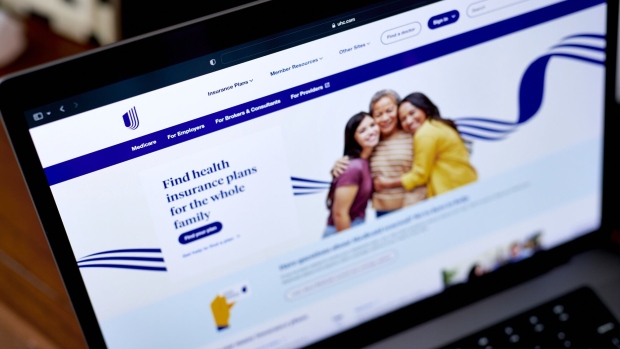Jan 12, 2024
UnitedHealth Beats Quarterly Profit, Revenue Estimates
, Bloomberg News

(Bloomberg) -- Health insurance stocks dropped early Friday after industry leader UnitedHealth Group Inc. reported higher medical expenses than investors anticipated.
The insurer’s unexpected miss on a crucial gauge of medical costs in the fourth quarter sent its shares down as much as 4.4% as of 10:38 a.m. in New York, the most intraday since June. All its major rivals fell on the result, a sign that investors think the sector may not have accurately priced for how people are getting medical care now that Covid concerns have faded.
Executives said they planned for some trends — such as more seniors getting orthopedic, cardiac and other outpatient procedures — to persist. But a year-end uptick in costs driven by RSV vaccinations and Covid care doesn’t appear “really durable or relevant to the rest of the year,” Chief Executive Officer Andrew Witty said on a call with analysts.
Wall Street became wary about health insurers in the middle of last year, when UnitedHealth warned that care expenses might exceed its target range for the year. They did. And the company’s medical-loss ratio — which shows how much premium revenue is paid for care — was far worse than Wall Street expected in the fourth quarter, even as overall results beat estimates.
Investors were already spooked after a CVS Health Corp. executive said at this week’s JPMorgan Healthcare Conference in San Francisco that medical costs late last year were higher than expected. Even companies that said their expenses were in-line with expectations — Centene Corp. and Cigna Corp. — saw their shares fall Friday after UnitedHealth’s results.
The sector traded down, with losses of as much 2.6% for Elevance Health Inc., 5.7% for Humana Inc., 1.7% for Cigna and 4% for CVS. The group had declined even more in trading before US markets opened.
Bellwether Signals
The largest US managed care company by market value, UnitedHealth is the first of the group to report quarterly earnings and its results are closely watched for signals about the broader industry.
The company’s medical-loss ratio was 85% in the quarter, the Minnetonka, Minnesota-based health insurer said Friday in a statement, exceeding analysts’ average forecast of 83.9%. Investors view a lower number more favorably, and the final result for the full year was also above the company’s target range.
Health insurer stocks often react to small changes in the measure, as investors see it as an indicator of profitability and how much patients are using health care. The higher care expenses are showing up in UnitedHealth’s Medicare business serving seniors, executives said.
The message for its commercial and Medicaid segments is “nothing to see here,” said Brian Thompson, CEO of insurance unit UnitedHealthcare, with costs coming in as expected.
Earnings Beat
Adjusted earnings were $6.16 a share in the last quarter of 2023, UnitedHealth said, compared to the $5.97 average of analysts’ estimates compiled by Bloomberg. Quarterly revenue of $94.4 billion beat Wall Street views by more than $2 billion. The company affirmed its 2024 adjusted earnings outlook.
The company’s Optum Health unit, which includes clinics, home care and other medical providers, saw profit of about $1.69 billion in the fourth quarter, dropping less than 0.1% from a year ago. Still, it was the second consecutive year-over-year decline at Optum Health, where profits have been rising since 2014, RBC Capital Markets analyst Ben Hendrix said in a note to clients.
Optum Health has been an important source of growth for UnitedHealth. The business serves millions of Medicare patients from UnitedHealthcare and other insurers, taking risk on their total medical costs, so its profits are also affected when care expenses rise. Profits grew at other Optum units that provide prescription drug services and data and consulting.
UnitedHealth told investors last month it would incur a $7 billion charge, most of it non-cash, on the planned sale of its Brazilian unit. The company said it will exclude the charge from adjusted results and record it when the deal closes, which is expected in the first half of the year.
The insurer lost 700,000 members in its Medicaid plans as states resumed checking eligibility for the safety net program last year after a pause during the pandemic. UnitedHealth added 800,000 commercial members in the year.
The company, which is the largest seller of private Medicare plans, added 100,000 members in its Medicare Advantage business during the annual open enrollment window. It still aims to add about half a million for the year.
A lower tax rate contributed 28 cents to adjusted earnings per share, according to Bloomberg Intelligence analyst Glen Losev. Stronger revenue growth across the business and operating income at Optum helped offset the higher medical costs, he wrote.
The report, including $100 million in medical expenses linked to earlier in the year, “conveys more pressure on ‘24 pricing than previously understood,” Jefferies analyst David Windley said in a note, while items like investment income, lower interest expense, and the favorable tax rate helped drive earnings.
(Updates with earnings call, analyst comments starting in third paragraph)
©2024 Bloomberg L.P.






